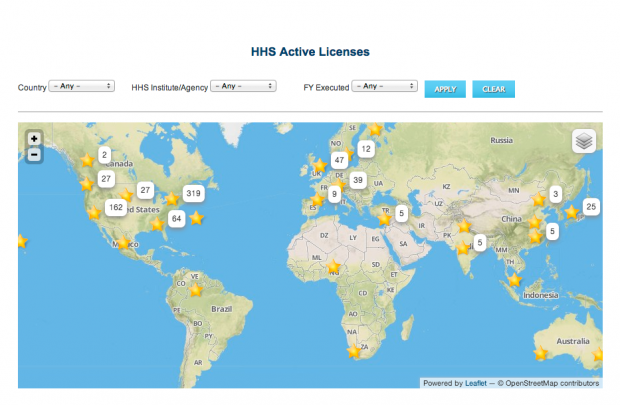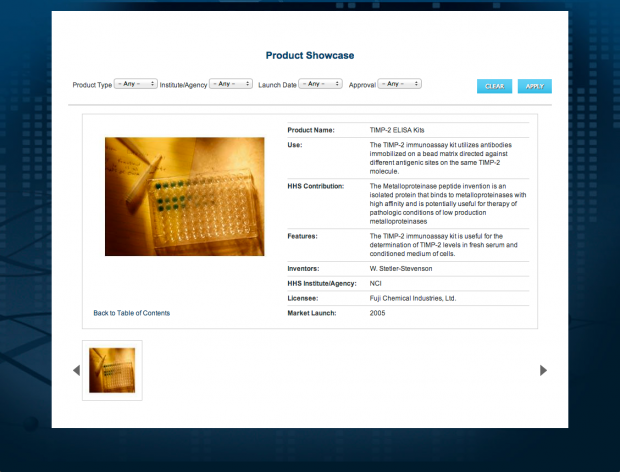 Support for Drupal 7 is ending on 5 January 2025—it’s time to migrate to Drupal 10! Learn about the many benefits of Drupal 10 and find migration tools in our resource center.
Support for Drupal 7 is ending on 5 January 2025—it’s time to migrate to Drupal 10! Learn about the many benefits of Drupal 10 and find migration tools in our resource center.Promet Source helped rebuild the National Institutes of Health, Office of Technology Transfer’s website. The project required legacy content migration, custom module development, eCommerce development and more to help for-profit companies source materials for internal research.
The National Institutes of Health (NIH), a part of the U.S. Department of Health and Human Services, is the United States' medical research agency - focusing on medical and scientific discoveries that improve health and save lives. NIH is the largest source of funding for medical research in the world, creating hundreds of thousands of high-quality jobs by funding thousands of scientists in universities and research institutions in every US state and around the globe.

Promet Source migrated an outdated eRMa website from a Microsoft.NET platform to Drupal. The old site was failing security audits and was not easy for administrators to modify. Drupal allowed the Promet team to pay close attention to security, flexibility and accessibility. Additionally, the system needed a maintenance overhaul which Drupal could provide to improve usability and cost-efficiency.
Thanks to Drupal, the new eRMa site now has enhanced functionalities (e.g. custom licensing templates) and features (e.g. a licensee dashboard page).
Challenge
NIH’s Office of Technology Transfer (OTT) challenged Promet Source to migrate an outdated eRMa website from a Microsoft.NET platform to Drupal. The old site was failing security audits and was not easy for administers to modify. Additionally, the system needed a maintenance overhaul to improve usability and cost-efficiency.
The new site would continue to use the website functionalities to help for-profit companies license unpatented research materials. Promet Source needed to develop a new site with that function enhanced with new functionalities and features: data integration, data display, product displays and license displays.
Solution
Promet Source implemented Drupal, an open source CMS to build the new eRMa site. Drupal was selected as the best tool to meet NIH’s needs in terms of security, flexibility, and usability. Adhering to best practices in project management & software development, Promet Source approached the eRMa project using Agile Software Development following Scrum methodology. The Project Manager assigned to the project is a certified Scrum master who led the multi-functional development team through efficient Sprint 0 planning, design, iterative prototyping, user-role creation, architecture, content development, navigation planning & creation, testing & quality assurance, site administrator training, and deployment. The project was broken into separate Sprints with a working version of the website available after each Sprint to collect feedback from the NIH.
The new eRMa site was born from a true collaboration with the NIH. Every aspect of the site was agreed upon by NIH; their input and needs are reflected in its design. The Iterative Protyping method allowed Promet and NIH to collaborate weekly. Each week, Promet provided an updated, working prototype which NIH could review and revise. This collaboration allowed Promet to efficiently meet NIH’s requirements.
Promet Source contributed highly technical solutions (eg custom module development, custom ecommerce development and integration and UI/UX optimization for ecommerce experience) to deliver a new site that was more secure and easier to use. The eRMa site now features enhanced functionalities including: LDAP integration, metrics data display, product showcase display, product pipeline display and a license & locations map. The product development pipeline is an entirely new feature for NIH users. To allow for these functionalities, the NIH relied on Promet’s deep technical expertise for complex data integration. The data for the product showcase, map, materials & licenses stem from separate data sources. Promet Source worked with the NIH team to refactor the data map and create reusable imports; we delivered a sustainable solution with a unified view of this data.
Implementation
The Agile Development methodology and Drupal were utilized to ensure the National Institutes of Health’s Office of Technology eRMa website was delivered by deadline and under budget.
LDAP (Lightweight Directory Access Protocol) integration was executed to tie the site to the federal government/NIH’s centralized authentication system. The metrics data display (“ttmetrics”) gives users of the site a single point of access to Commonly Tracked Metrics at the NIH Office of Technology Transfer. Users can analyze data (e.g. Licenses in a Fiscal Year by Type of Agreement, Royalty Income by Type) in charts and graphs provided in one convenient landing page.
The product showcase is a single source of reference for users to research products that have been developed under license with the NIH. The user can filter their research by product type, issuing institute/agency, launch date and approving agency. Users can easily find information regarding a product’s (e.g antibodies) use, inventor, features and more.
The product development pipeline display (an entirely new feature) allows eRMa site users to research projects that are in different stages of development. Scientists can access information about specific treatments and products: phase of trial, licenses, etc. Users can narrow their searches by disease category, treatment type, phase of clinical trial and more.
The “NIH Light the World” map displays licenses and locations on a global map. Users can search active licenses and filter results by country, issuing agency and fiscal year. The Light the World Map uses a mapping library that allows users to interactively narrow down to regions of the world to see licenses. Promet took this feature a step further; if there is a product associated with the license, users can click to the linked product showcase report.
Promet Source developed the eRMa site from an enormous system based on a proprietary framework to an open source framework which administrators can update and maintain easily. NIH was pleased with the overall solution, especially the new features: product development pipeline and the metric data display. Further, the eRMa site improves the efficiency of research scientists. Global researchers can now be aware of available materials. They can access info on material purchasing as opposed to relying on their own limited networks. The site enables global communication and expedites medical and scientific research.
Technical specifications
Feeds was chosen as a solution for data import
The Geo-Cluster was used to built the "Lights Up the World Map"- The “NIH Light the World” map displays licenses and locations on a global map. Users can search active licenses and filter results by country, issuing agency and fiscal year. The Light the World Map uses a mapping library that allows users to interactively narrow down to regions of the world to see licenses. Promet took this feature a step further; if there is a product associated with the license, users can click to the linked product showcase report.
Using the Commerce, Rules and Workflow modules allowed Promet to successfully build eRMa: The Electronic Research Materials Catalogue (eRMa) is a web-based catalogue intended for licensing of research materials to for-profit companies from the Office of Technology Transfer (OTT). The catalogue was developed to expedite the process for transferring unpatented research materials to for-profit entities.

